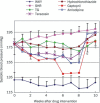Differential regulations of blood pressure and perturbed metabolism by total ginsenosides and conventional antihypertensive agents in spontaneously hypertensive rats
- PMID: 20686518
- PMCID: PMC4091415
- DOI: 10.1038/aps.2010.86
Differential regulations of blood pressure and perturbed metabolism by total ginsenosides and conventional antihypertensive agents in spontaneously hypertensive rats
Abstract
Aim: To investigate the regulatory effects of total ginsenosides and the conventional antihypertensive agents (captopril, amlodipine, terazosin and hydrochlorothiazide) on the blood pressure and perturbed metabolism in spontaneously hypertensive rats (SHRs) and to analyze the cause-effect relationships between high blood pressure and the metabolic disorders of hypertension.
Methods: SHRs were administrated with total ginsenosides or the antihypertensive agents for eight weeks. Systolic blood pressure (SP) was measured every week and low-molecular-weight compounds in blood plasma were quantitatively analyzed using a nontargeted high-throughput metabolomic tool: gas chromatography/time of flight mass spectrometry (GC/TOFMS) . The metabolic patterns were evaluated using principal components analysis and potential markers of hypertension were identified.
Results: Total ginsenosides and the antihypertensive agents differentially regulated SP and the metabolic pattern in SHRs. Total ginsenosides caused a progressive and prolonged reduction of SP and markedly normalized the perturbed metabolism with 14 of 27 (51.8%) markers of hypertension which were regulated toward normal. Total ginsenosides also reduced free fatty acids' level toward normal levels. In contrast, captopril, amlodipine and terazosin efficiently depressed SP, but had little effect on metabolic perturbation with only 8 (29.6%), 4 (14.8%), and 4 (14.8%) markers, respectively, which were regulated.
Conclusion: The metabolic changes persisted when the blood pressure was lowered by the conventional antihypertensive agents, suggesting that hypertension may not be the cause of the metabolic perturbation in SHRs.
Figures


Similar articles
-
[Slowing the progression of chronic renal insufficiency with captopril in rats with spontaneous arterial hypertension and adriamycin nephropathy].Srp Arh Celok Lek. 2002 Mar-Apr;130(3-4):73-80. doi: 10.2298/sarh0204073j. Srp Arh Celok Lek. 2002. PMID: 12154518 Serbian.
-
Transient prehypertensive treatment in spontaneously hypertensive rats: a comparison of losartan and amlodipine regarding long-term blood pressure, cardiac and renal protection.Int J Mol Med. 2012 Dec;30(6):1376-86. doi: 10.3892/ijmm.2012.1153. Epub 2012 Oct 9. Int J Mol Med. 2012. PMID: 23064712
-
Notoginsenoside R1 reduces blood pressure in spontaneously hypertensive rats through a long non-coding RNA AK094457.Int J Clin Exp Pathol. 2015 Mar 1;8(3):2700-9. eCollection 2015. Int J Clin Exp Pathol. 2015. PMID: 26045775 Free PMC article.
-
Comprehensive characterisation of phenolics from Nitraria sibirica leaf extracts by UHPLC-quadrupole-orbitrap- MS and evaluation of their anti-hypertensive activity.J Ethnopharmacol. 2020 Oct 28;261:113019. doi: 10.1016/j.jep.2020.113019. Epub 2020 Jun 12. J Ethnopharmacol. 2020. PMID: 32540258
-
Hemorheological effects of amlodipine in spontaneously hypertensive rats.Indian J Pharmacol. 2017 Jul-Aug;49(4):312-316. doi: 10.4103/ijp.IJP_176_16. Indian J Pharmacol. 2017. PMID: 29326492 Free PMC article.
Cited by
-
Common Metabolites in Two Different Hypertensive Mouse Models: A Serum and Urine Metabolome Study.Biomolecules. 2021 Sep 21;11(9):1387. doi: 10.3390/biom11091387. Biomolecules. 2021. PMID: 34572600 Free PMC article.
-
Effect of coadministration of enriched Korean Red Ginseng (Panax ginseng) and American ginseng (Panax quinquefolius L) on cardiometabolic outcomes in type-2 diabetes: A randomized controlled trial.J Ginseng Res. 2021 Sep;45(5):546-554. doi: 10.1016/j.jgr.2019.11.005. Epub 2019 Nov 14. J Ginseng Res. 2021. PMID: 34803424 Free PMC article.
-
Dissecting the Regulation of Arachidonic Acid Metabolites by Uncaria rhynchophylla (Miq). Miq. in Spontaneously Hypertensive Rats and the Predictive Target sEH in the Anti-Hypertensive Effect Based on Metabolomics and Molecular Docking.Front Pharmacol. 2022 May 30;13:909631. doi: 10.3389/fphar.2022.909631. eCollection 2022. Front Pharmacol. 2022. PMID: 35712719 Free PMC article.
-
Metabolomics profiling in hypertension and blood pressure regulation: a review.Clin Hypertens. 2020 Nov 15;26(1):23. doi: 10.1186/s40885-020-00157-9. Clin Hypertens. 2020. PMID: 33292736 Free PMC article. Review.
-
Compound danshen dripping pills modulate the perturbed energy metabolism in a rat model of acute myocardial ischemia.Sci Rep. 2016 Dec 1;6:37919. doi: 10.1038/srep37919. Sci Rep. 2016. PMID: 27905409 Free PMC article.
References
-
- Yach D, Leeder SR, Bell J, Kistnasamy B. Global chronic diseases. Science. 2005;307:317. - PubMed
-
- Kearney PM, Whelton M, Reynolds K, Whelton PK, He J. Worldwide prevalence of hypertension: a systematic review. J Hypertens. 2004;22:11–9. - PubMed
-
- Jones DW, Hall JE. World Hypertension Day 2007. Hypertension. 2007;49:939–40. - PubMed
-
- Lifton RP, Gharavi AG, Geller DS. Molecular mechanisms of human hypertension. Cell. 2001;104:545–56. - PubMed
-
- Charchar FJ, Zimmerli LU, Tomaszewski M. The pressure of finding human hypertension genes: new tools, old dilemmas. J Hum Hypertens. 2008;22:821–8. - PubMed
Publication types
MeSH terms
Substances
LinkOut - more resources
Full Text Sources
Medical
Miscellaneous

